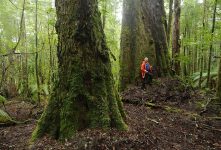The Forest Wars: An Interview with Long Time Forest Campaigner Warrick Jordan

From the 1980s, right up until the early 2000s, the logging of old growth forests was the most prominent environmental issue in Australia. And what’s referred to as the forest wars – a conflict between environmentalist groups and the logging industry – raged throughout the country.
It was a battle fought on non-violent terms, rather than any hand to hand combat. Direct actions and blockades were carried out, in conjunction with media campaigns and political debates.
And that’s where the Regional Forest Agreements (RFAs) came in. These 20-year agreements between federal and state governments were designed to create growth and jobs for the logging industry, protect the environment and quell the social conflict.
The RFA system
Between 1997 and 2001, ten RFAs were established in the states of Tasmania, Victoria, Western Australia and NSW. The East Gippsland RFA was set to expire this month, although it’s been given a last-minute twelve-month extension. And the Tasmanian agreement will expire later this year.
RFAs allow for the logging of public native forests, and unlike other forestry actions, those covered under these agreements are not required to obtain approval under federal environmental laws.
According to 2012 estimates, there are 9.4 million hectares of native forest on public lands that allow for wood production in Australia. This logging has a long-term impact on these native forests and the wildlife that’s dependent on them.
The Environment Protection and Biodiversity Conservation Act 1999 (EPBC Act) is the main piece of federal environmental legislation. It applies to “matters of national environmental significance.” However, the Regional Forest Agreements Act 2002 provides that RFAs are exempt from the EPBC Act.
New battle lines drawn
For the most part, the forest wars have been resolved around the country. Although, in Victoria and Tasmania the battle lines are still drawn over species that are being threatened with extinction due to logging.
However, the forest wars are set to be fought along different lines now. This time the conflict is between the various Australian governments and environmentalist groups, with the disagreement being the renewal of the RFAs.
And it seems, to some extent, the logging industry agrees with the greenies this time.
RFAs have failed
On May 6 last year, the federal and Tasmanian governments released a joint report calling for the renewal of the Tasmanian RFA. It was the same day the Tasmanian swift parrot was listed as critically endangered, due to the impacts of logging.
Indeed, the federal government is committed to rolling over all ten RFAs without even updating the decades old agreements.
However, environmentalists point out that RFAs have failed to ensure that logging didn’t negatively impact biodiversity. While over the last two decades the RFAs have been in place, the logging industry has been hit hard. Australia’s largest timber company Gunns collapsed in 2012.
Established in 1976, the Wilderness Society has been at the frontline of the forest wars since the beginning. But over the last half decade they’ve changed tactics. Today, they seek to find common ground with the logging industry, and work to support forests together in a more effective way.
Sydney Criminal Lawyers® spoke with Warrick Jordan, a long time forest advocate, about why the RFAs have failed and what this means for the future of native forests.
Firstly, what were Regional Forest Agreements designed to provide? And what have they provided?
The primary intent of RFAs was political. In the early 1990s, there was a huge national conflict over forest resources. Should they be used for conservation or should they be used for the logging industry? And that got out of control.
The Commonwealth had a fair amount of responsibility for determining what those outcomes would be. In the mid-90s, the conflict got so great that Paul Keating made a decision to try and reduce that conflict by essentially handing over a lot of the power for managing forestry issues to the states.
The primary function of the RFAs was a political one, which meant responsibility for environmental impact assessments or protecting threatened species or regulating logging that got sent directly to the states.
So that was the political and primary rationale behind them.
But from a legal point of view, the idea behind the RFAs was to put in place a stable framework for how forests were regulated and protected, and how much wood would be determined as sustainable to come out of those forests.
The other couple of relevant aspects is that they were an attempt to protect forests, either through national parks or through regulation of logging, for conservation values – like certain species, or old growth forests – that would usually be protected nationally.
This is one of our beefs with them, as they’ve essentially failed to do that in any meaningful way.
The other relevant part is that it was an attempt to provide resource security for the forestry industry. Essentially that means providing them with a stable source of wood that allows them to produce products and have a stable investment climate.
And I think the demonstrable evidence has been that they’ve also failed on that front as well.
So it was primarily a political intent. There was a legal framework intent and then there was the specific objectives of the RFAs, which were around conservation, regional communities, employment and the industry.
And then the other thing they were designed to do is to take the heat out of the community conflict as well.
This was done to varying degrees. And because they were run as state-Commonwealth enterprises in different places, in some the outcomes were better, and in others they were worse.
And you can see now, as the industry has started to look at market governance, so forest certification like FSC, it’s a way to demonstrate they’ve got social licence to people who want to buy wood.
If the RFAs achieved their intent of managing that conflict and delivering social licence, then that sort of certification wouldn’t actually be required. But all the state forest agencies and logging companies are looking at that.
Today, many parties involved in the debate state that RFAs have been an outright failure. What sort of condition are these old growth forests and rainforests that are covered by the RFAs in?
The RFAs took a target based approached for the protection of different ecosystems, including old growth. They were done to varying degrees of effectiveness.
But each RFA had what they called a comprehensive regional assessment, which was probably the most extensive bit of science that’s been done on a lot of these forests.
So what they did was say, this type of vegetation exists, and we’re going to set a target for that.
The general figures were if there was a lot of a particular type of forest, you’d protect 15 percent of it. In a national park, if there wasn’t much of it, then you’d protect 50 percent. And if there was hardly any of it, then you’d protect all of it.
So as far as the old growth goes, there were targets for protecting a portion of it, usually 60 percent, depending on the place.
From a conservationist point of view, what we’ve always argued is that any old growth forest is important and should be protected. It’s where all ecosystem processes are at their most natural and effective.
Industry will argue that if you can save some of the old growth forest, then you are essentially saving enough of that function to allow a forest to work as it should.
They’re the opposing arguments.
But for us really the proof is in the pudding. If you look at eastern Victoria – so East Gippsland, Central Highlands, and so on – you’ve seen over 20,000 hectares of old growth, and other forests that are quite similar, knocked over in operations since the RFA started.
And so that’s a good indicator for us that if the objectives of the RFAs were to try and protect old growth forests, then they’re not actually working to do that effectively.
In May last year, the federal and Tasmanian governments recommended renewing the Tasmanian RFA, on the same day the swift parrot was listed as critically endangered.
What’s the situation like for native fauna living in these forests that are being logged?
It’s the biggest problem that we have in forests in Australia. You have these threatened species that are highly dependent on particular structures in the forests, like hollow bearing trees. And so they get directly impacted by logging.
You can see it in most states. In Tasmania, the swift parrot is now being listed as critically endangered, despite it being identified under the Tasmanian RFA as a priority species for protection.
There’s leadbeater’s possum that’s been listed as critically endangered in the last year in Victoria. And it’s heavily threatened by logging.
You’ve got greater gliders, which weren’t listed nationally as threatened, and have been listed this year. And logging is one of their key threats as well. That’s an issue in Victoria and NSW.
The western ringtail possums in WA are in really bad shape, and they’re impacted by logging. It starts to become the pointiest example of what the impacts of logging are.
Where that starts to cross over with some of the legal and legislative environments is that these species get listed under federal law, under the EPBC Act. And under that act there’s a range of instruments, like recovery plans, which are supposed to ensure the protection of these species.
But what happens is that under an RFA, you’re effectively exempt from national environmental law, and what that means in practice is that instead of a logging operation that’s going to damage swift parrot habitat having to go to the federal environment minister to be assessed that doesn’t happen.
So the logging is just assessed and approved under whatever the state based regime may be for assessing logging. And that varies in quality, but essentially it’s the same in most places where you have your state forest manager, who goes out there and does all the planning.
There’s generally a pretty low bar in terms of the regulatory structures that try and protect these species.
This is our biggest issues with the RFAs. Because it effectively exempts all of these areas from federal environmental laws.
So you see wildlife, like swift parrot and leadbeater’s possum, being turned into critically endangered species, without the federal government having any actual legislative levers to be able to try and protect these species.
And it looks like a huge failure of law for the government to not be able to actually protect these species that they are legally obliged to protect.
So would the EPBC Act stop the logging of these endangered species habitat?
It wouldn’t necessarily stop it. There’s a range of other weaknesses within the EPBC Act. For example, you do see a fair swathe of endangered species habitat being knocked over for housing developments, or mines, or whatever the case may be.
So as an act, it’s not perfect. But our issue is that because there is no federal government oversight, then it means those impacts don’t get considered in the way they should by the federal government.
Our assessment would be in a number of cases that logging operations wouldn’t proceed, or would have to proceed differently in a way that wouldn’t impact those species.
In Tasmania, there was a case in 2006, the Wielangta case that Bob Brown brought – which was all about the swift parrot and a couple of other species – and the federal court’s conclusion at the time, was that the RFAs required both governments to have plans in place to protect the swift parrot.
However, under the letter of the RFA, and the nature of the exemption from federal environmental law, they didn’t actually need to protect the species, they just had to plan to.
And so, in terms of the performance of the law it’s not actually delivering protection to the threatened species. In fact, the reverse is happening under the RFAs, they’re becoming more endangered, not less.
The RFAs override the federal legislation, allowing for logging of native forests. You’ve said that this is a shocking example of what happens when the federal government hands over responsibility for nature conservation to the states. In your opinion, why don’t state governments prioritise nature conservation?
There’s two reasons why we’d like the federal government to be more involved in regulation of logging and other damaging environmental activities.
One is that we believe the federal government has much better oversight. They manage a whole continent. And they can actually see what is going on and have that responsibility.
But the other issue is having those additional layers. Having both a state and federal government essentially allows you to back stop situations, when a state government may be doing the wrong thing. Or alternatively, the federal government may be doing the wrong thing.
But the primary issue is that the state governments are quite heavily conflicted when it comes to forests, because the managers of the forests are government-owned corporations, so Forestry Tasmania, VicForests and so on. And that’s the case in all areas.
So you have these companies that are run by the state that have a commercial imperative to be able to produce timber. And at the same time that state government is expected to regulate that industry, and sometimes it works OK. It depends on the particular government in question and their receptiveness to environmental issues.
And it depends quite strongly on what the institutional arrangements are that are set up in a particular state. So where you have a well-resourced independent regulator with strong enforcement powers, you end up with a better outcome. But none of that has happened consistently.
In NSW, at some stages the environmental protection authority has been strong and been able to effectively regulate the industry. At other times, because of government pressure or lack of resourcing or changes to the rules, they’re not actively able to regulate the industry effectively.
The state governments are inherently conflicted because they own these companies that make money out of logging. And if the political conditions don’t favour strong regulatory and institutional arrangements to allow logging to be regulated properly, then there’s nowhere else to go.
The RFAs were meant to create certainty for the logging industry. What effect have they had on this industry? And what condition is the Australian logging industry in today?
The industry is in varying degrees of difficulty. In Tasmania, the industry has been in freefall for the best part of ten years. It’s stabilised a little bit recently.
But as a tool to ensure industry certainty of supply and viability, it’s pretty hard to escape the conclusion that the RFAs have been a failure.
You won’t get many people from the forestry industry saying that publicly. And that’s primarily because even though they haven’t worked, some level of certainty around the legal environment is worth hanging onto.
But really when you look at the evidence, the number of jobs in the native forest sector has declined in every state and region, since the RFAs.
The amount of wood that’s been produced by the industry has declined a great deal.
The markets have dried up. The industry relied heavily on export woodchip markets and they’ve largely been replaced. Not totally, but largely been replaced by plantation timber, both from Australia and elsewhere.
If you look at the way the industry has acted, in Tasmania, they got into a situation where they needed to create an agreement with conservation groups to get access to markets, because they needed to be able to sell their product and support their industry.
So that doesn’t look like the actions of a sector that sees the RFAs as having fixed all their problems.
And then, as I was saying before, in relation to our Forest Stewardship Council certification, I think, all of the state forest agencies, or companies who buy wood from them, have recently sought or are seeking FSC certification, so that they can get access to markets.
And the reason for that is the existing structures don’t provide enough certainty to the market place that logging has been done in a way that looks after the environment and the community.
And so on all those fronts, if you look at the statistics in terms of dollars, wood, or jobs, or if you look at the actions of the industry in trying to find alternative ways to do what the RFAs were supposed to do, you have to conclude that they have not been effective from an industry point of view.
But the industry will still hang onto them in the absence of any alternative legal framework. And they do like the exemption from the EPBC Act, as it makes their lives easier in getting logging approved.
So if environmental groups and some parts of the logging industry are critical of the RFAs, why are the federal and state governments looking at renewing them?
From the conservation point of view, the answer is, we don’t have enough influence to be able to get an alternative structure put up.
I would also add a self-critique of the environmental movement, in that we’ve been quite strong in opposing the RFAs, but quite poor in proposing concrete alternatives.
The industry doesn’t have a lot of motivation to get rid of the RFAs. From the industries point of view, the RFAs can just sit there and have their helpful exemption from the EPBC Act. So there’s little incentive for them to repeal the RFAs.
Given forest isn’t an issue that is front of mind for government in the same way that it used to be, and the forestry industry, particularly the native forest sector is much weaker and employs a lot less people, there is little incentive for any government, looking at the scale of the industry, to go and pick the scabs of the forest conflict and come up with a big new alternative policy.
What’s the alternative the Wilderness Society would recommend?
Our biggest view on federal environmental law is that we need a new act. There’s some reasonable components of the existing act. But the thing that it really misses is independent institutions and independent research that underpins the decisions that government makes.
We’d be looking at an independent body that would do assessments of whether there was going to be impacts on environmental values from a development and then they would make recommendations to the minister.
So that’s on a principle level, but practically when it comes down to forestry, the way we see the alternatives, is that we get the forestry industry doesn’t want to go back to getting every hundred hectares of logging approved by the federal environment minister.
But the way we would see it is that it would be similar to the way forestry companies need to deal with certification.
They would submit a five-year logging plan that would say, these are the areas that we are going to log. This is how we are going to manage the impacts on conservation values, and then that plan would be ticked off or rejected or forced to be modified by a federal minister.
So similar to the way impact assessments are managed now. But what is really required is decent research, decent data and the ability for independent experts to be able to make recommendations.
Lastly, if logging continues on as it is at present under the current RFA system, what do you predict is going to happen in these old growth forests in the future?
It will vary from place to place. But when you look at species like the swift parrot and the leadbeater’s possum that suffer from a range of stress, but primarily from logging operations, they will go extinct.
You’re looking at extinction within three or four generations of those species, so over the next twenty or thirty years.
For other species, like greater gliders, you will start to see quite serious declines.
What you’ve got in a lot of the logging areas are small patches of older forest, or old growth forest, that are shrinking and shrinking.
And it’s quite well-known that once you start fragmenting those types of forest and not replacing some of the older forest with growing forest, then you end up in a situation where a lot of the processes and functions of the ecosystem start to fall apart.
So unless there’s some changes to the way logging is managed to protect those kind of values then you’ll just see these areas turn from what resembles a natural forest now to landscapes that pretty much look like forestry plantations.
Warrick thanks very much for taking the time out to have this chat with us today. And continued success with your organisation’s campaigning to protect our precious environment.
Well, we’ll see how we go. We’re working hard.







